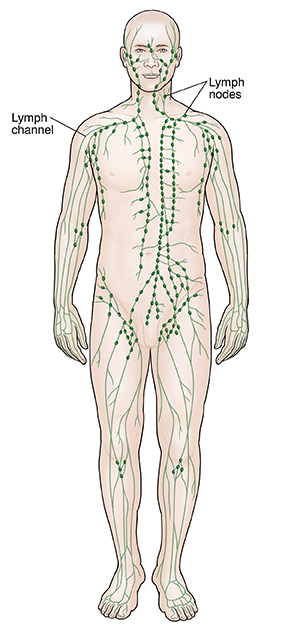The lymphatic system is a part of the immune system. It helps fight against infection and inflammation. It consists of lymph glands (lymph nodes) throughout the body. Lymph channels or vessels carry lymph fluid from parts of the body to nearby lymph glands to be filtered.
Lymphangitis is an inflammation of lymph channels. It may be due to infections or noninfectious causes. The infection may be caused by infected lymph fluid traveling from a site of infection. Or it's from a break in the skin where germs were able to enter. Noninfectious causes include cancers and noncancerous (benign) tumors that may block the lymph vessels causing inflammation.
Symptoms are tender, red streaks on the skin. These are often on the legs or arms. They often start near the area of infection or the entry point for the germs. Sometimes the red streaks are only on the upper leg or upper arm, many inches from where the infection started. The spot where the infection started may not be obvious.
The condition can become very serious if not treated. Any apparent infection and the lymphangitis aretreated with antibiotics. If you have an abscess, it may be drained.
Home care
-
Take all medicine to treat the infection exactly as prescribed until it's gone. Be very careful not to miss any doses. If you miss a dose, call your provider. Don't stop taking the medicine until it's finished or your healthcare provider tells you to stop, even if you feel better.
-
Follow your healthcare provider's instructions for taking other medicines. Ask your healthcare provider before taking any over-the-counter medicines.
-
Make a warm compress by running hot water over a face cloth. Apply it to the sore area until the compress cools off. Repeat 4 to 6 times a day for the first 3 days. The heat will increase the blood flow to the area and speed the healing process. You can also stand in the shower and direct the warm spray to the area.
Follow-up care
Follow up with your healthcare provider, or as directed.
When to get medical advice
Call your healthcare provider or get medical care right away if any of the following occur:
-
Increasing areas of redness or pain at the site of infection
-
Red streaks continue to grow
-
Pus or fluid draining from the lymph node
-
Fever of 100.4°F (38°C) or higher, or as directed by your healthcare provider.
-
You have new symptoms
Featured in


